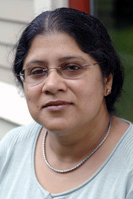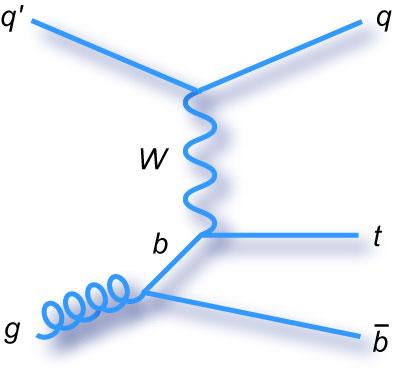PROVIDENCE, R.I. [Brown University] — Brown physicists have played a key role in observing particle collisions that produce a single top quark, one of the fundamental constituents of matter. The discovery was announced Monday by scientists of the CDF and DZero collaborations at the Department of Energy's Fermi National Accelerator Laboratory.
Meenakshi Narain, professor of physics at Brown, has been involved with DZero since the early 1990s. In 1995, Narain was a member of the DZero group at Fermi that discovered the top quark and the anti-top quark. She called the finding of a single top quark “kind of a dream come true.

“For me this is like a 14-year journey that has come to a close,” said Narain, who provided the analysis that helped scientists separate the single top quark from observational clutter. “We have discovered the top quark in pairs. Now we can see it produced singly in a rare mode by the weak force, which means we can understand its properties better.”
Brown graduate student Monica Pangilinan is a member of the team that made the single top quark discovery. Brown physicists David Cutts, one of the founding members of the DZero experiments, and Greg Landsberg also are active in the DZero tests. The DZero group comprises 600 physicists from 90 institutions in 18 countries.
The teams submitted their results last week to Physical Review Letters.
The scientists found the single top quark through proton-antiproton collisions at Fermi, which operates the Tevatron, currently the world's highest-energy particle collider. Previously, top quarks had only been observed when produced by the strong nuclear force. That interaction leads to the production of pairs of top quarks. The latest discovery involves the weak nuclear force and is harder to identify experimentally.
The discovery of the single top confirms important parameters of particle physics, including the total number of quarks, and has significance for the ongoing search for the Higgs particle at Fermilab and at the Large Hadron Collider, the world's largest superparticle collider in Switzerland that is expected to begin operations anew this fall after suffering a malfunction last year.
Only one in every 20 billion proton-antiproton collisions produces a single top quark. Even worse, the signal of these rare occurrences is easily mimicked by other background processes that occur at much higher rates.
“I am thrilled that CDF and DZero achieved this goal,” said Fermilab Director Pier Oddone. “The two collaborations have been searching for this rare process for the last 15 years, starting before the discovery of the top quark in 1995. Investigating these subatomic processes in more detail may open a window onto physics phenomena beyond the Standard Model.”
Discovering the single top quark production presents challenges similar to the Higgs boson search in the need to extract an extremely small signal from a very large background. Advanced analysis techniques pioneered for the single top discovery are now in use for the Higgs boson search. In addition, the single top and the Higgs signals have backgrounds in common, and the single top is itself an important clue for the Higgs particle.
“Today's discovery is tomorrow’s background,” Narain said.

